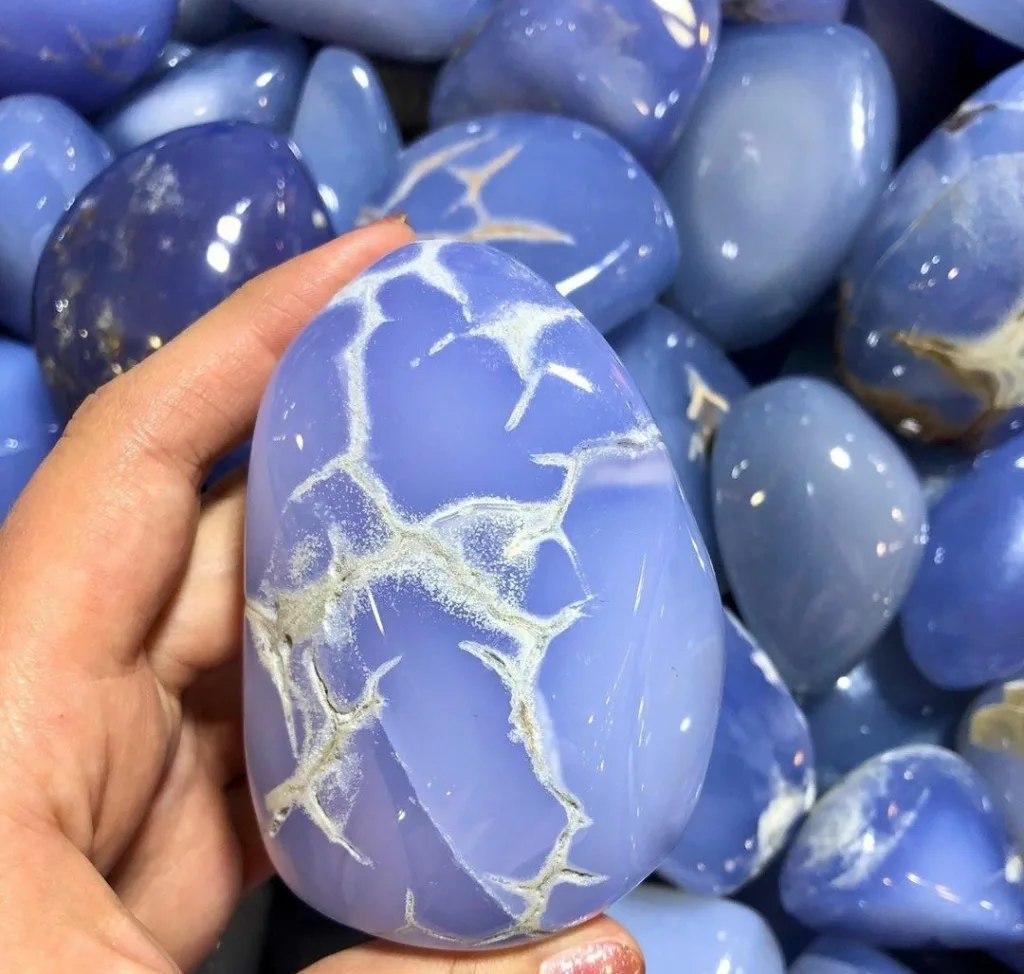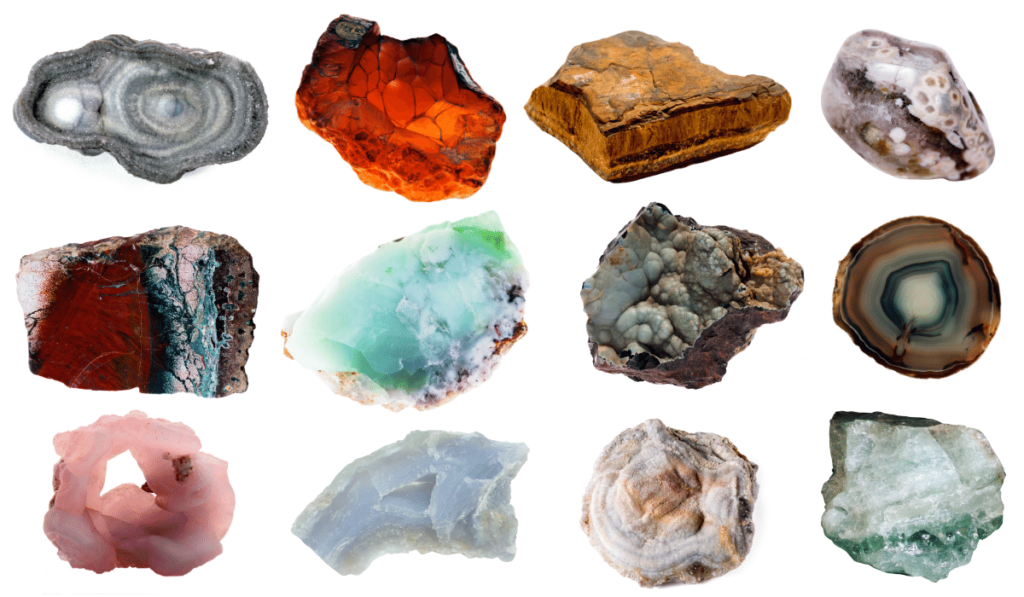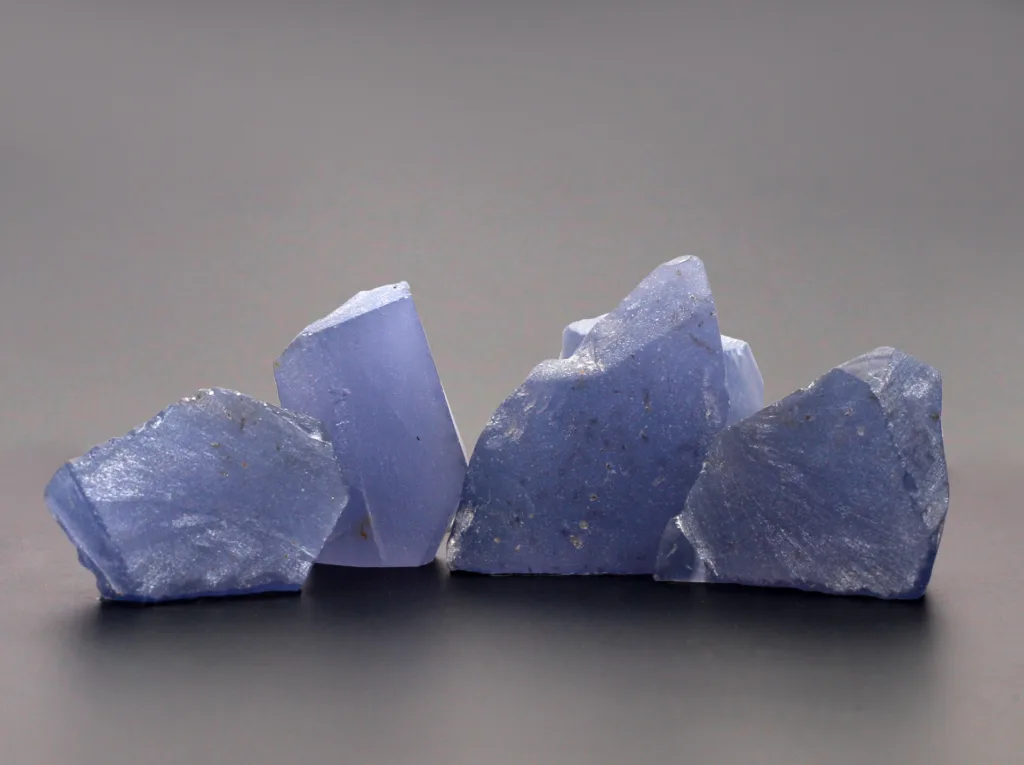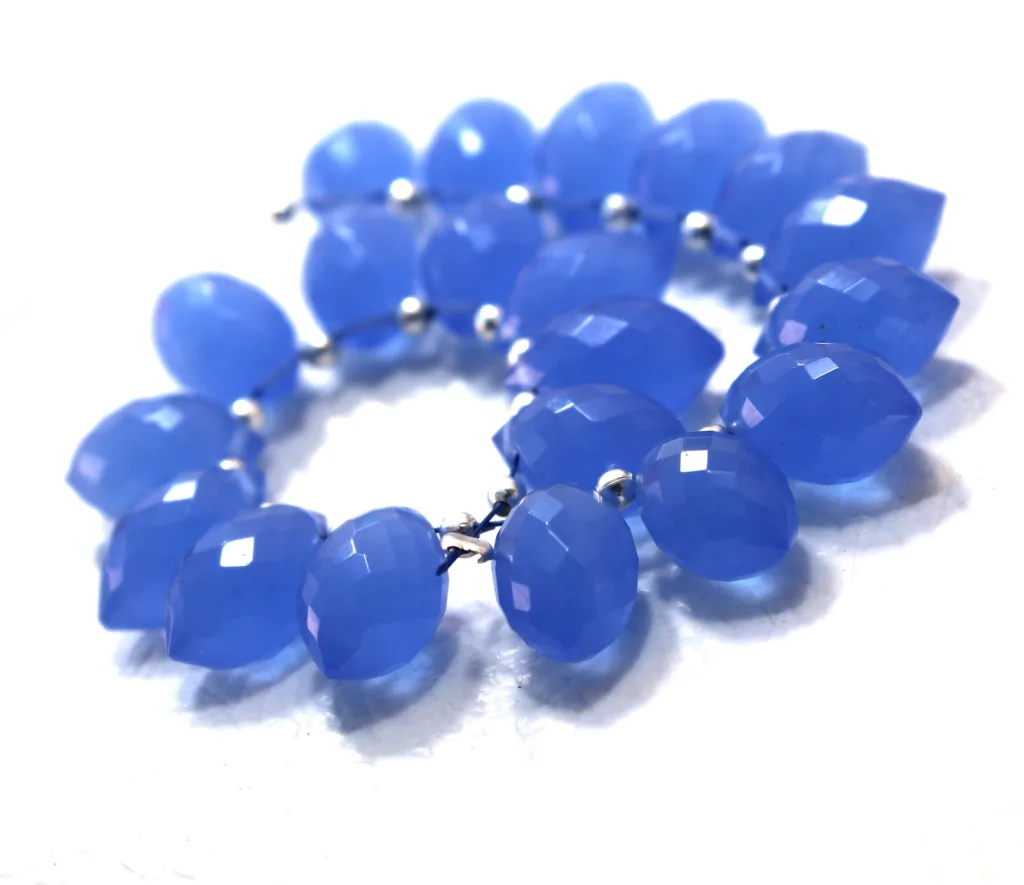Blue chalcedony is a type of microcrystalline quartz that is known for its beautiful blue color and translucent appearance. It is a variety of chalcedony, which is a cryptocrystalline form of quartz, meaning that its crystals are too small to be seen with the naked eye. Blue chalcedony gets its color from the presence of trace amounts of iron and other impurities.

Geological Formation: Blue chalcedony forms in a variety of geological settings, but it is commonly associated with volcanic rocks and can be found in geodes, cavities, and fractures within these rocks. It often develops as a result of silica-rich fluids that percolate through these cavities and deposit tiny quartz crystals over time. The blue coloration is typically attributed to the presence of blue minerals such as celadonite or other manganese-bearing compounds.
Characteristics and Properties:
- Color: Blue chalcedony is known for its soft and soothing blue color, which can range from pale to vivid blue. The color can sometimes have hints of gray or green.
- Transparency: It is typically translucent, allowing light to pass through, which gives it a lovely glow when polished or cut into gemstones.
- Hardness: Blue chalcedony has a Mohs hardness of 6.5 to 7, which makes it relatively durable and suitable for use in jewelry.
- Luster: It has a waxy or vitreous luster, which enhances its visual appeal when polished.
- Pattern: Blue chalcedony often displays banding or concentric ring patterns, especially when cut and polished.
- Fracture: It has a conchoidal fracture, meaning it breaks with smooth, curved surfaces like broken glass.
- Origin: Blue chalcedony is found in various parts of the world, including Brazil, Madagascar, Namibia, and the United States.
Metaphysical and Healing Properties (Note: These are not scientifically proven):
- Blue chalcedony is believed to have calming and soothing properties, making it popular in crystal healing practices for reducing stress and promoting inner peace.
- It is associated with the throat chakra and is believed to enhance communication, self-expression, and the ability to speak one’s truth.
- Some people use blue chalcedony for emotional healing and to alleviate anxiety and depression.
- It is also thought to enhance creativity and artistic expression.
It’s important to note that the metaphysical properties of gemstones are based on belief systems and are not supported by scientific evidence. If you are interested in using blue chalcedony for healing or spiritual purposes, it’s a good idea to consult with a qualified practitioner or explore these practices with an open but critical mindset.
Types of Chalcedony

Chalcedony is a cryptocrystalline variety of quartz and is known for its wide range of colors and patterns. There are several different types of chalcedony, each with its own unique characteristics and properties. Here are some of the most well-known types of chalcedony:
- Agate: Agate is one of the most common and popular varieties of chalcedony. It comes in a wide range of colors and often exhibits banded patterns, concentric rings, or other intricate designs. Agate is often used for making cabochons, beads, and carvings.
- Carnelian: Carnelian is a reddish-orange to orange variety of chalcedony. It is known for its vibrant color and translucency. Carnelian has been used for centuries in jewelry and ornamental objects.
- Chrysoprase: Chrysoprase is a green variety of chalcedony that gets its color from the presence of nickel. It can range from pale green to a deep, apple-green color. Chrysoprase is valued for its attractive green hues and is often used in jewelry.
- Onyx: Onyx is a banded variety of chalcedony that usually consists of black and white bands. It can also come in other color combinations, such as brown, red, or blue. Onyx is often used for making cameos and beads.
- Sardonyx: Sardonyx is a type of onyx that combines layers of brownish-red sard with white bands. This variety is prized for its contrast between the rich red and the white bands.
- Moss Agate: Moss agate is characterized by its green to blue-green color and the presence of dendritic or moss-like inclusions that resemble foliage or plant structures. It is often used for cabochons and ornamental carvings.
- Blue Chalcedony: As mentioned earlier, blue chalcedony is a variety of chalcedony known for its soothing blue color. It is used in jewelry and is believed to have calming properties.
- Bloodstone: Bloodstone, also known as heliotrope, is a green chalcedony with red or brown spots. The red spots are often attributed to the presence of iron oxides. It has been used as a gemstone and for carving.
- Plasma: Plasma is a type of chalcedony that is predominantly green with streaks or spots of red. It is a less common variety but is sometimes used in jewelry.
- Sagenite: Sagenite chalcedony contains needle-like or hair-like mineral inclusions, typically rutile or goethite. These inclusions can create striking patterns within the stone.
- Prase: Prase is a leek-green to dark green variety of chalcedony. It is often translucent and is sometimes used as a gemstone or for carvings.
These are just a few of the many types of chalcedony, and the diversity of colors and patterns within the chalcedony family is quite extensive. Each type of chalcedony has its own unique beauty and is used for various purposes, including jewelry, carvings, and ornamental objects.
Mineral Composition and Structure of Blue Chalcedony

Blue chalcedony is a variety of chalcedony, which is itself a microcrystalline form of quartz. It has a specific mineral composition and structure that define its characteristics. Here’s an overview of the mineral composition and structure of blue chalcedony:
Mineral Composition:
- Silicon Dioxide (SiO2): Like all types of chalcedony, blue chalcedony is primarily composed of silicon dioxide, which is the chemical compound SiO2. This compound forms the fundamental building blocks of the mineral.
Structure:
- Microcrystalline Structure: Blue chalcedony exhibits a microcrystalline or cryptocrystalline structure, which means that its crystals are too small to be seen with the naked eye. Instead of forming large, well-defined crystals, chalcedony consists of extremely tiny crystalline structures that are tightly packed together.
- Fibrous and Cryptocrystalline Aggregates: The structure of blue chalcedony consists of fibrous and cryptocrystalline aggregates. These aggregates are composed of extremely small quartz crystals and fibers that are densely intergrown. This structure contributes to the stone’s translucent appearance.
- Amorphous Zones: Within the microcrystalline structure, there are also amorphous zones where the arrangement of silicon and oxygen atoms lacks long-range order. This amorphous nature contributes to the waxy or vitreous luster that chalcedony often exhibits.
Color and Coloration Mechanism:
- The blue color in blue chalcedony is usually attributed to the presence of trace amounts of other minerals or impurities. In the case of blue chalcedony, it is often iron or manganese that imparts the blue coloration. These impurities can absorb specific wavelengths of light, resulting in the blue appearance observed in this variety.
Translucency and Luster:
- Blue chalcedony is known for its translucency, which means it allows light to pass through, but not as clearly as transparent minerals. This property, along with its microcrystalline structure, gives it a soft and glowing appearance.
- The luster of blue chalcedony is typically waxy or vitreous, which further enhances its aesthetic appeal when it is cut and polished.
Overall, blue chalcedony’s mineral composition and microcrystalline structure contribute to its distinctive appearance, including its beautiful blue color and translucent quality. These characteristics make it a sought-after gemstone for use in jewelry and ornamental objects.
Geographical Sources

Blue chalcedony can be found in various geological locations around the world. It is commonly associated with volcanic or sedimentary environments where silica-rich fluids have deposited quartz in cavities, fractures, or geodes. Some of the notable geographical sources of blue chalcedony include:
- Namibia: Namibia is well-known for producing high-quality blue chalcedony, particularly from the Erongo region. The gem-quality blue chalcedony from Namibia is highly regarded for its vivid blue color and translucency.
- Brazil: Brazil is another significant source of blue chalcedony. Brazilian blue chalcedony is often found in geodes and nodules. The state of Minas Gerais is a notable area for blue chalcedony deposits.
- Madagascar: Madagascar is a source of various chalcedony varieties, including blue chalcedony. The material from Madagascar is known for its rich blue color and can be found in different regions of the country.
- United States: Blue chalcedony is also found in the United States. States like Oregon and California have known deposits of blue chalcedony, and it is often used by lapidaries and jewelry artisans.
- India: Blue chalcedony can be found in India, particularly in the Deccan Plateau region. Indian blue chalcedony may vary in color and quality.
- Other Locations: Blue chalcedony can also be found in other regions, including Australia, Mexico, Turkey, and various parts of Africa.
The quality and appearance of blue chalcedony can vary depending on its source, with some locations known for producing particularly vibrant and attractive specimens. Gemstone enthusiasts and jewelry makers often seek blue chalcedony from these different regions based on their individual preferences for color and clarity.
Uses of Blue Chalcedony

Blue chalcedony, with its soothing blue color and attractive appearance, has a variety of uses in jewelry, spiritual practices, and ornamental objects. Here are some of the common uses of blue chalcedony:
- Gemstone Jewelry: Blue chalcedony is frequently used in jewelry design. It can be cut into cabochons, faceted stones, beads, and other shapes to create rings, necklaces, earrings, bracelets, and pendants. The calming and attractive blue color makes it a popular choice for both casual and formal jewelry.
- Carvings and Cameos: Due to its relatively high hardness, blue chalcedony is suitable for carving intricate designs and cameos. Skilled artisans create beautiful carvings and relief sculptures from this gemstone, often featuring scenes, motifs, or intricate patterns.
- Tumbled Stones: Blue chalcedony is sometimes tumbled to create smooth, polished stones that are used as decorative items, worry stones, or in meditation practices. These tumbled stones can fit comfortably in the hand and are often used for stress relief and relaxation.
- Metaphysical and Spiritual Practices: In metaphysical and healing practices, blue chalcedony is believed to have calming and soothing properties. It is associated with the throat chakra and is thought to enhance communication, self-expression, and inner peace. Some people use blue chalcedony in meditation or carry it as a talisman for emotional healing and balance.
- Home Decor: Blue chalcedony can be used for decorative purposes in homes and offices. It can be displayed as polished specimens, used as paperweights, or integrated into decorative items such as tabletops, sculptures, and figurines.
- Lapidary Art: Blue chalcedony is appreciated by lapidaries and artisans for its versatility in creating custom jewelry pieces, sculptures, and other lapidary art forms. Its unique color and translucency can be incorporated into various artistic projects.
- Collectibles: Some collectors seek out rare and high-quality blue chalcedony specimens as collectible gemstones. Unique patterns and exceptional coloration can add value to these collectible pieces.
- Spiritual and New Age Jewelry: Blue chalcedony is often used in jewelry designed for spiritual or New Age practices. It is believed to promote harmony, reduce stress, and aid in communication, making it a popular choice for those who incorporate gemstone energy into their daily lives.
It’s important to note that while blue chalcedony has been attributed with various metaphysical properties, these beliefs are not scientifically proven. Individuals who choose to use blue chalcedony for spiritual or healing purposes do so based on personal beliefs and practices.




































